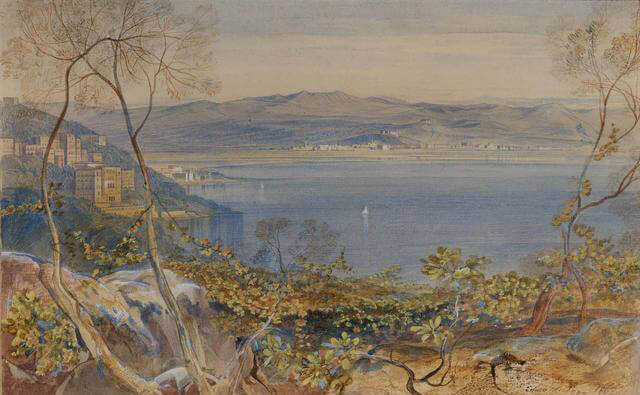Few people know the history and quirks of the Gulf of Poets (or Gulf of La Spezia) as well as Gino Ragnetti. He is a journalist who has worked with several Italian newspapers and media outlets since 1960.

Born in the region of Emilia Romagna in 1942, he moved to his mother’s village Marola (a fraction of La Spezia) when he was just 6 months old… and has never left the shores of the Gulf of Poets ever since. Throughout the years he has written and collaborated in the writing of many books dedicated to history and protagonists of La Spezia and the villages along its bay.
Discover Portovenere Blog had the pleasure of interviewing Gino Ragnetti.
Who was the first “testimonial” of the Gulf of Poets?
There is a debate among historians on whether Portus Lunae designated the Gulf of Poets (like I believe) or the mouth of the Magra River (which flows in the sea of the Bay of Spezia anyhow). For sure it was the port where the Romans reunited their fleet for their operations in the Mediterranean. If we consider Portus Lunae to be the Gulf of Poets, then the first testimonial was Quintus Ennius (c. 239 – c. 169 BC), who is often considered the father of Roman poetry. After stopping in the area as a soldier following a mission in Sardinia, he said: ” Lunai portum, est operae, cognoscite, cives!” (citizens, you must get to know the port of Luna, it’s worth it!). He included this praise in his “Annales” epic poem, as confirmed by Roman poet and satirist Aulus Persius Flaccus. It is said that Persius (34 – 62 a.C.) was born in Volterra (Tuscany), but according to several historians he was actually from La Spezia because while staying there he felt the need to dedicate a poem to the shores of what he called “my Ligurian sea”. So, the first known testimonials were Ennius in 205 a.C., followed by Persius three centuries later.
For centuries, the Gulf of Poets has been considered a destination for elite tourism. Who was the first to document tourism in the area and when?
When it comes to books and documents, the word “tourism” related to the Gulf of La Spezia appears towards the mid-1800s. But some books from the 1700s also hint at the vacation destination, by talking about the presence of many “second homes”. If we look at the many archaeological findings in the Gulf of Poets, then it was a spot for tourism already at the time of the Romans. Traveling poets praised the beauty of the area, such as Dante Alighieri (1265 – 1321) who visited Punta Corvo. But organized tourism in the Gulf of Poets developed after 1823, when the road connection to Genoa was opened, as Spezia was quite isolated before that. That’s how international travelers on the Grand Tour, especially coming from France and Germany, discovered the province of La Spezia on their way to Rome and other parts of Italy.

The Gulf of Poets was praised by so many historic figures and artists. Which are your favorite quotes and by whom?
One of my favorites is by John Stuart Mill, one of the most important economists of the 1800s. He arrived in La Spezia on 1 January 1855. The carriage had left him in Borghetto, several kilometers away, and he walked all the way to La Spezia in the cold winter landscape. When he saw the Gulf in front of him, he was mesmerized. As soon as he arrived at the hotel, he wrote a letter to his wife saying: “I think that this is the most beautiful place I have ever seen in my life”. An influential person like John Stuart Mill must have travelled to many different places around the world, yet this is what he had to say of our Gulf! This same sentence was pronounced by Irish novelist Charles James Lever, who lived in La Spezia for 16 years. Following his stay in Liguria, Stuart Mill continued his travels all the way to Rome, where he wrote to his wife: “With the exception of Spezia, Rome is the only place of this Italian journey where I contemplated the idea of stopping to live for some time”. Overall, he would mention La Spezia 24 times in the letters to his wife… how could he have left her at home?!
Another quote that touched me is by Rebecka Mendelssohn, granddaughter of the famous German Jewish philosopher Moses Mendelssohn. She visited the Gulf of Poets in 1843, and once in Florence she wrote to her sister, who was also traveling around Italy: “I cannot understand how you can talk about Italy when you have never seen Spezia.”
What about the famous poets that are traditionally associated with the Gulf of Poets, like Percy Bysshe Shelley?
Shelley was in love with the Gulf of La Spezia. He came for the first time with his wife Mary Shelley towards the end of 1821. He came back with his friend Williams to look for a vacation home for his family, servants, and friends – including Lord Byron. The problem was that around La Spezia they could not find a house that could accommodate all of Byron’s things, since he travelled with carriages full of books and even farm animals. The relationship between the artists eventually strained, and that’s when the Shelley’s chose Villa Magni in San Terenzo. This area inspired Percy so much that he wrote “Lines written in the bay of Lerici” and “Triumph of Life” (the latter was his last major work before his death in 1822, and was left unfinished).

Do you have any other curiosity or little-known fact about Gulf of La Spezia that you would like to share?
Few people know that this area was of huge interest to science, in fact scientists from all over the world came here for 2 things.
The first was the climate, as La Spezia had gained a reputation of being the ideal destination for people with lung problems and doctors travelled here to check whether this was true or not. Some agreed, some did not.
The second thing that interested scientists was the Polla di Cadimare. This underwater spring gathered so much strength when it rained, that the pressure would lead to the creation of a sort of liquid hill on top of the sea. Today we know it is a water spring, but at the time scientists were not so sure of what caused the phenomenon. Even Lazzaro Spallanzani (1729 – 1799) came to study the Polla di Cadimare and created a small machine to try to understand what was going on under the sea.

The Polla di Cadimare was also a sort of tourist attraction, and some sailors would try to go on top of the liquid hill with their boats. With the building of the Arsenale (La Spezia Naval Base) in the 1860’s, it became more difficult to notice the phenomenon on the sea, but the Polla is still there.
And now let’s talk a bit about you. How many years did you dedicate to collecting documents and writing your latest book “Quanto sei bella Spezia!” and previous books regarding the Gulf of Poets?
To write my latest book, I “looted” about 900 pages from one of my previous works, Ottocento – Quando Spèza divenne Spezia (published in 2011), a voluminous book that took me 5 years to write. Thanks to the internet, collecting books and documents for Quanto sei bella Spezia! (published in 2018) was a lot easier and quicker, and it took me about one year and a half to write it. I found an amazing online portal with more than 20.000 books about La Spezia. I was able to check 18.000! We have to thank the Americans in particular for scanning so many old and new books and putting them online. For example, I found out that my first book, called Tavolara, l’isola dei re (2005) is in the Library of Congress in Washington, D.C.
When did you start writing books about the Gulf of La Spezia?
I started in 1983 by collaborating with a dear friend of mine, Arrigo Petacco, in the publication of the volumes called La Spezia in Guerra, which covered five years of war in the territory. Following my first book on the Kingdom of Tavolara Island, I explored archaeology and history in the Gulf of Poets with Luna, una misteriosa città romana nel golfo della Spezia (2007).
Thank you very much, Gino!
More Sources:
Gino Ragnetti’s Blog
Spezia nell’Ottocento Facebook Group
Discover more from Discover Portovenere Blog
Subscribe to get the latest posts sent to your email.
1 Comment